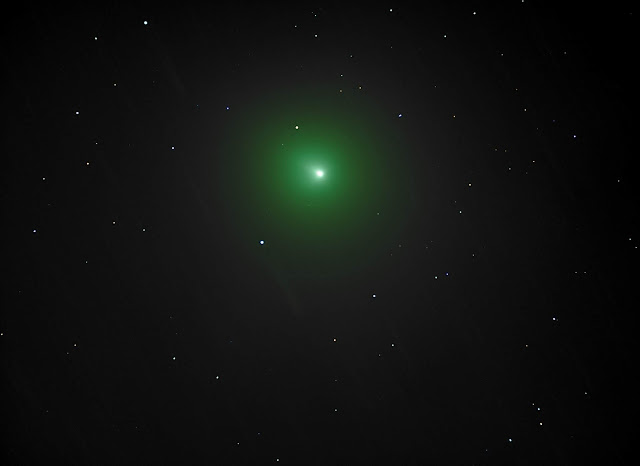 |
| Comet 46P/Wirtanen |
Constellation: Taurus
Distance: 0.0806 AU (7.5 million km)
Date: December 12th. 2018
Equipment: ATIK 460EX, Vixen 114mm f5.3 ED114 refractor, NEQ6 mount, guiding with Lodestar X2/PHD
Subframes: 30 x 120s luminance, 20 x 30s each for RGB (for comet, same again for stars). Additional 60s (30 taken) and 30s luminance frames (70 taken) were also obtained (see below) in this session.Equipment: ATIK 460EX, Vixen 114mm f5.3 ED114 refractor, NEQ6 mount, guiding with Lodestar X2/PHD
Comet 46P/Wirtanen was discovered by Carl A. Wirtanen in 1948 at the Lick Observatory,
Comet 46P/Wirtanen has an orbital
period of approximately 5.4 years and belongs to the “Jupiter Family” of comets. Jupiter-family comets will occasionally have
their orbits perturbed when they make a close approach to Jupiter because its
strong gravitational field can alter (sometimes quite significantly) a
comet's path through space.
In the case of 46P/Wirtanen, it underwent two such
interactions with Jupiter (in April 1972 and February 1984) that pushed its
orbit about 50 million miles closer to the sun as well as very near to the
orbit of Earth.
Perihelion passage of comet Wirtanen will be on 16 December
2018 when it will pass 0.078 AU (7,220,000 miles) from Earth. Close though this encounter is, the comet is
relatively small in size with an estimated nuclear diameter of just 1.2
kilometers (unlike the Great Comet of 1997, Hale-Bopp, with its 60 km
nucleus) and so will not appear to be particularly bright.
46P is expected to reach magnitude 3, but this light is spread out a bit across the comet’s visual area which, unlike a star, is not a point source. It
is therefore right at the limit of naked eye visibility. I could not see it without binoculars, even
though I knew exactly where to look. This
is the brightest prediction of known and future passes of this comet. This is also currently the brightest
prediction for all comet passes in 2018, although even by the usual UK tabloid’s
moronic standards, it can hardly be described as a “head-scorcher”….
Sensible information about 46P Wirtanen can be found here.
Sensible information about 46P Wirtanen can be found here.
The "seeing" on the evening of December 12th. was horrendous. Focussing was a challenge as star shapes fluctuated wildly between focus frames. I initially gathered 70 x 30 second luminance frames and 20 x 30 second frames in RGB, (plus a further 20 x 30 second RGB frames for star colour once the comet had drifted out of the field of view). No evidence of a tail could be seen. Setting PHD to guide on the comet nucleus seemed to work fairly well, although the longer subs at 60 seconds and 120s seem to be plagued with noise and gradients - I think some high cloud had set in. This made processing a bit difficult and it took a few iterations to get the noise reduction and background brightness into a presentable image. The 120s subs did show a hint of a tail and the final result is shown above. The shorter sub stacks did not show much in the way of cometary detail but are shown below.
A map of the comet's perihelion passage through the constellation of Taurus is shown below:
 |
| Track of 46P through Taurus, 11-16 December (position marked every 12h) |
Using the sigma stacking function in Astroart, and "one star" alignment gave an image of the comet with star trails virtually eliminated. The LRGB stack showed the bright green colouration of the comet itself. I layered the RGB star stack over it to give coloured stars in the final images.
 |
| 46P - Larson Sekanina filtered image |
The striking green fuzzball (see an explanation of the colour here) rather dominates the image and it was a bit tricky to stop it being spoiled by an "onion ring" brightness gradient, which I still haven't completely eliminated. The core does show a tiny bit of detail and a hint of a tail.
The AstroArt image processing programme offers something called a Larson-Sekanina filter, which uses a lot of complex math to allegedly pull out cometary detail from raw comet images. Applying this to the luminance data stack gives a result (left) does seem to show a tail and other additional details that correspond to faint features in the colour image above.
Below is a GIF animation using the 70 x 30 second luminance frames from above, showing the comet moving against the sky background.
 |
 |
| Comet 46P Wirtanen - (stack of 30s subframes) |
 |
| Comet 46P Wirtanen - (stack of 60s exposures) |































